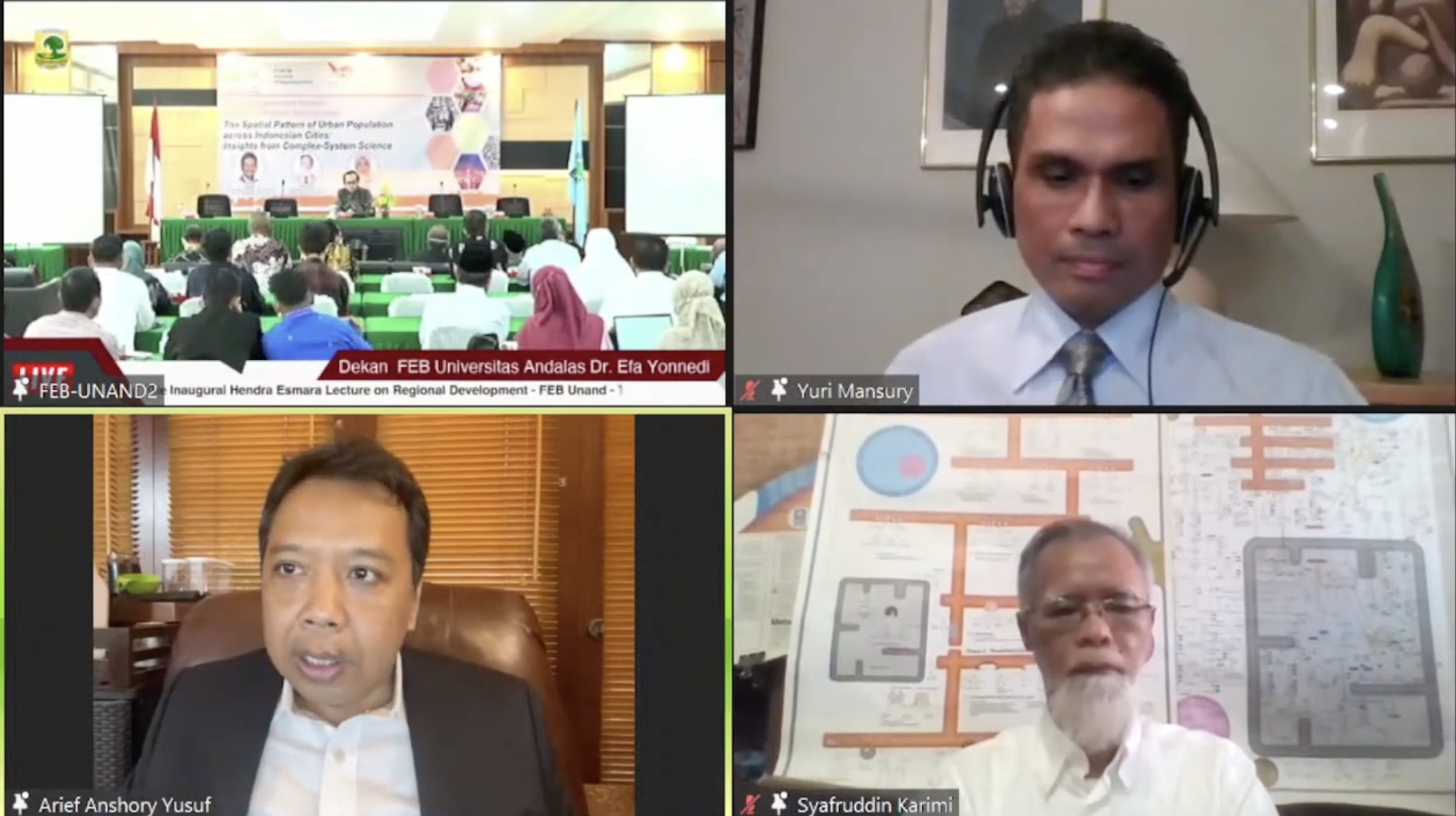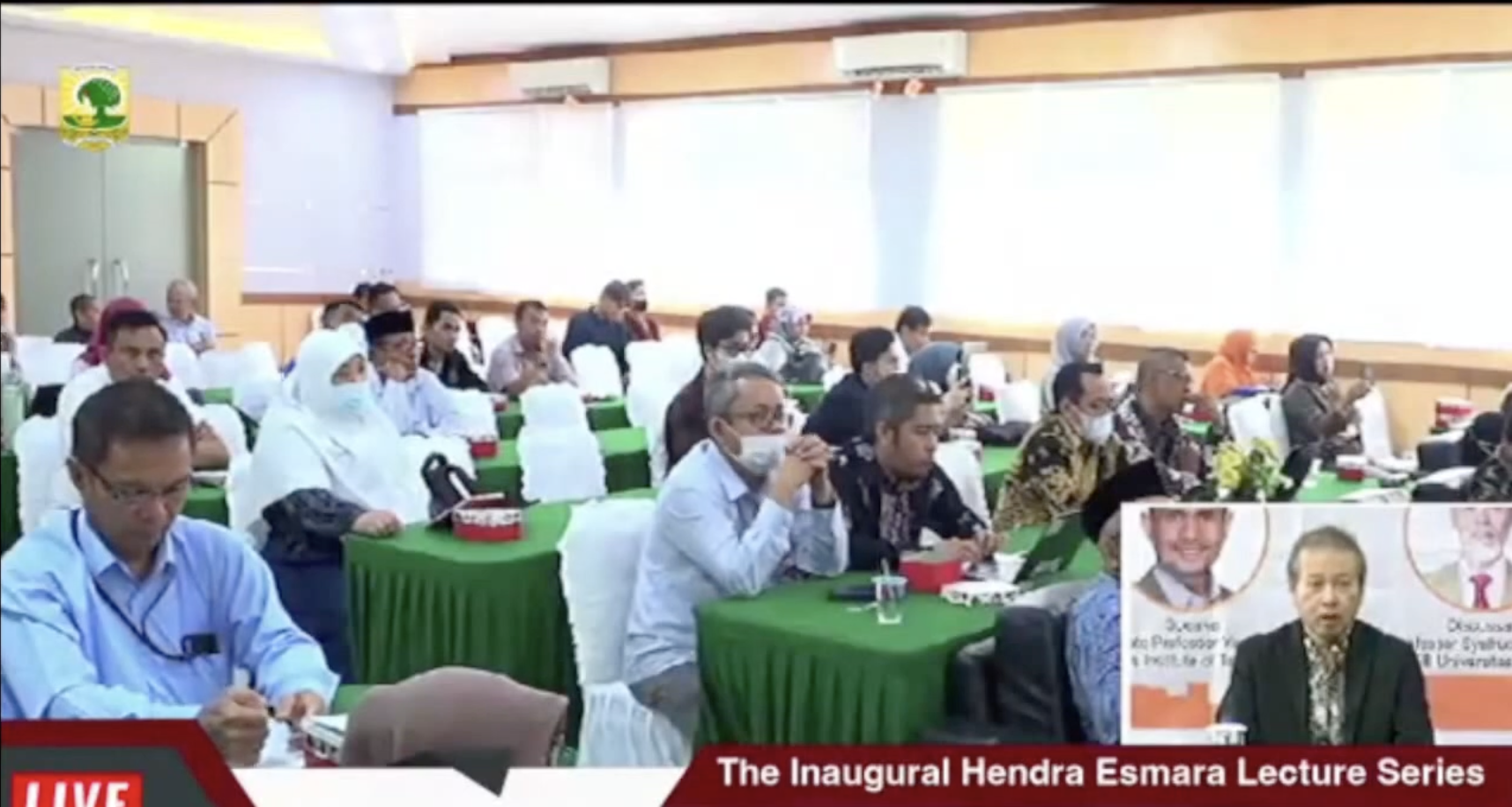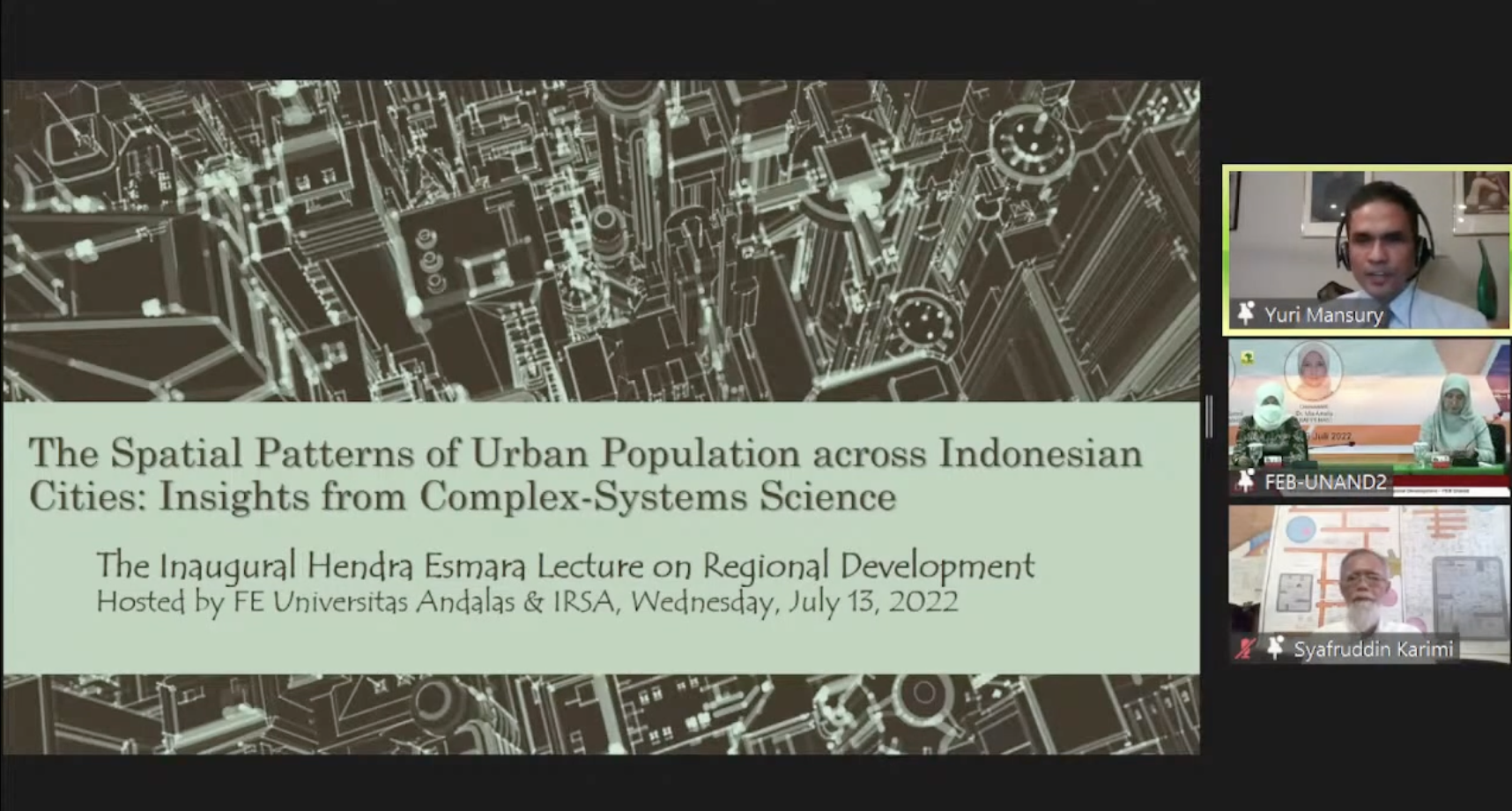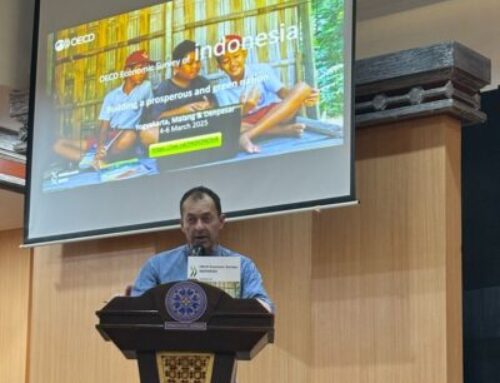This FKP seminar was held in person at Universitas Andalas (Padang) and online on Zoom, hosted by Faculty of Economics Universitas Andalas and the Indonesian Regional Science Association (IRSA). Associate Professor Yuri Mansury (Illinois Institute of Technology, USA) delivered the inaugural Hendra Esmara Lecture, and Professor Syafruddin Karimi (Universitas Andalas) and Mia Amalia (BAPPENAS) were discussants. Dr Efa Yonnedi (Dean, Faculty of Economics and Business Universitas Andalas) and Professor Arief Anshory Yusuf (President of IRSA) delivered the welcoming and keynote remarks. Professor Budy P. Resosudarmo (The Australian National University) introduced the Lecture series and Hendra Esmara’s contributions on the study of regional development in Indonesia. Lembaga Penelitian Ekonomi Regional (LPER) at Universitas Andalas was re-launched at the event. About 280 people attended the Lecture (190 people attended online and 90 people attended in person in Padang).
KEY POINTS:
- Cities are complex interactions of many autonomous, heterogeneous actors. If one tries to aggregate these individual behaviors into an equation, one might come into a fallacy because the aggregate outcome is not necessarily the reflection of the individual intent. The capacity of the human mind for formulating and solving complex problems is very small compared with the size of the problems whose solution is required for objectively rational behavior. To understand cities, we must view them not simply as places in space but as systems of networks and flows.
- Future urbanization policies can be directed to induce a sustainable transformation of urbanization through changes in human behavior: by understanding urbanization from the point of view of individual behavior and interactions and decentralized decision-making process assisted by meaningful modeling and simulations. An understanding of the evolution including future scenarios of the city size and distribution in Indonesia is essential in designing a more equitable and sustainable regional development.
SUMMARY
- The Hendra Esmara Lecture on Regional Development was convened by the Faculty of Economics Universitas Andalas and the Indonesian Regional Science Association in honor of the late Professor Hendra Esmara for his pioneering work in the field of regional analysis in Indonesia. Professor Esmara served as advisor to numerous Indonesian government agencies including Badan Pusat Statistik and BAPPENAS. He actively participated in managing the Indonesian Association for Economists and supported the career of many junior economists in academia and government. In the early 1960s, Hendra Esmara saw the need to pay more attention to regional disparities in Indonesia and in 1967 established the Institute for Regional Economic Research (Lembaga Penelitian Ekonomi Regional) at Universitas Andalas, the first institute that focused on regional development in Indonesia. His pioneering publication in 1971 in the Bulletin of Indonesian Economic Studies was among the first comprehensive papers on regional income disparities in Indonesia and marked the birth of regional analysis in the country. Yuri Mansury, Associate Professor at Illinois Institute of Technology, was the speaker of the inaugural Hendra Esmara Lecture. His areas of research are the economics of technology and innovation, computational modeling of urban systems, spatial networks, disaster impact analysis, and unbalanced regional development seminar talks about the spatial patterns of urban population across Indonesian cities.
- For most of human history, populations lived in very low density rural settings. Urbanization is a trend unique to the past few centuries. The year 2007 was the first year when, for the first time, more people worldwide lived in urban areas. Today, more than 4 billion people live in urban areas globally. By 2050 it is projected that more than two thirds of the world population will live in urban areas.
- Population growth captures the extent to which cities are becoming increasingly attractive habitats and labor markets. Cities with ‘good’ characteristics, such as low manufacturing exposure, high education, and low employment, grow faster. Based on the 2000 Population Census, urbanization in Indonesia remained concentrated in a few large agglomerations, in particular in the Jakarta Metropolitan Area. Nevertheless, convergence appeared underway as the largest Indonesian cities (including Jakarta, Surabaya, Bandung, Medan, and Semarang) grew more slowly than the nation. Cities in the outer islands are even more likely to be characterized by the blending of agricultural and industrial activities, the faster growth in those cities is consistent with the dynamics of a “desa-kota region” also known as “mega-urbanization,” a desa-kota refers to the fusion of rural and urban areas into an interconnected market area
- Understanding spatial patterns and regional development must consider the complexity of cities as systems. Cities are complex interactions of many autonomous, heterogeneous actors. If one tries to aggregate these individual behaviors into an equation, one might come into a fallacy because the aggregate outcome is not necessarily the reflection of the individual intent. Many of the things we measure have a typical size/scale, but not all things are peaked around a single value. Some vary over an enormous dynamic range, sometimes many orders of magnitude: The sizes of cities (and towns) are a classic example.
- The capacity of the human mind for formulating and solving complex problems is very small compared with the size of the problems whose solution is required for objectively rational behavior. To understand cities we must view them not simply as places in space but as systems of networks and flows. The rising complexity has created the need for theoretically-robust reconstruction of urban systems through human behavior in space to shed light on how we interact with one another in contemporary cities
- One of the missions in National Urban Policy 2045: Towards Sustainable Urban Development 2045 is realizing a balanced, prosperous and equitable national urban system (Spatial Sustainability). There are 5 policies and strategies for that mission: strengthening globally competitive metropolitan and national activity centers, developing well-connected medium-large-metropolitan cities outside Java, developing a new national government center (New Capital City of Nusantara), Developing non-exploitative and mutually-beneficial rural-urban linkages, and developing Smart Urban Growth and Effective Urban Growth Boundaries.
- In her discussion, Mia Amalia ( BAPPENAS) focused on the Indonesian government’s approach on urban planning, stressing that cities are open and complex systems, continually exchanging resources, products and services, waste, people, ideas, and finances with the broader world, and encompass multiple actors with varying responsibilities, capabilities, and priorities as well as processes that transcend the institutional compartmentalization of city administration.
- The spatial pattern of the urban population can be utilized as an input for the preparation of the national long-term development plan 2025-2045. Future urbanization policies can be directed to induce a sustainable transformation of urbanization through changes in human behavior: by understanding urbanization from the point of view of individual behavior and interactions and decentralized decision-making process assisted by meaningful modeling and simulations. An understanding of the evolution including future scenarios of the city size and distribution in Indonesia is essential in designing a more equitable and sustainable regional development.







